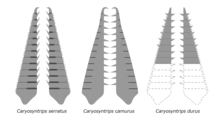Caryosyntrips
Appearance
| Caryosyntrips Temporal range:
| |
|---|---|

| |
| Frontal appendages of Caryosyntrips | |
| Scientific classification | |
| Kingdom: | |
| Phylum: | |
| Class: | |
| Order: | |
| Genus: | †Caryosyntrips
Daley & Budd, 2010 |
| Type species | |
| Caryosyntrips serratus Daley & Budd, 2010
| |
| species | |
Caryosyntrips is an extinct genus of Radiodont which existed in Canada and the United States[1] during the middle Cambrian. Caryosyntrips is known only from a handful of 14-segmented frontal appendages[1], which resemble nut-crackers, recovered from the Burgess Shale Formation. It was first named by Allison C. Daley, Graham E. Budd in 2010 and the type species is Caryosyntrips serratus.[2]
References
- ^ a b c d Stephen Pates; Allison C. Daley (2017). "Caryosyntrips: a radiodontan from the Cambrian of Spain, USA and Canada". Papers in Palaeontology. 3 (3): 461–470. doi:10.1002/spp2.1084.
- ^ Allison C. Daley, Graham E. Budd (2010). "New anomalocaridid appendages from the Burgess Shale, Canada". Palaeontology. 53 (4): 721–738. doi:10.1111/j.1475-4983.2010.00955.x.
External links
